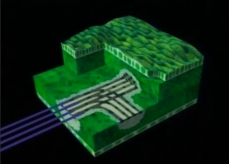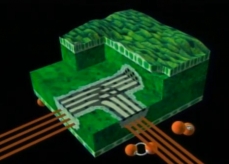Transcription of video clip Cells and light
Photosynthesis: using solar energy
Photosynthesis allows trees to build new tissues.
Thanks to a green pigment called chlorophyll, the leaf uses energy from the sun's rays to produce sugars from water and carbon dioxide.
Carbon dioxide enters the leaf through pores called stomata.

© Jardin botanique de Montréal
Water is transported to the leaves.
Water drawn from the soil moves through the tree to the leaves.
The water is broken down into hydrogen and oxygen. The hydrogen then combines with carbon dioxide from the air to form glucose, a sugar.

© Jardin botanique de Montréal
The leaf produces glucose and oxygen.
The glucose is sent to the rest of the tree, while the oxygen is released into the air.
That's how the tree produces the sugars it needs to build tissues and survive, and releases a waste gas, the oxygen we breathe.
Back to video clip




